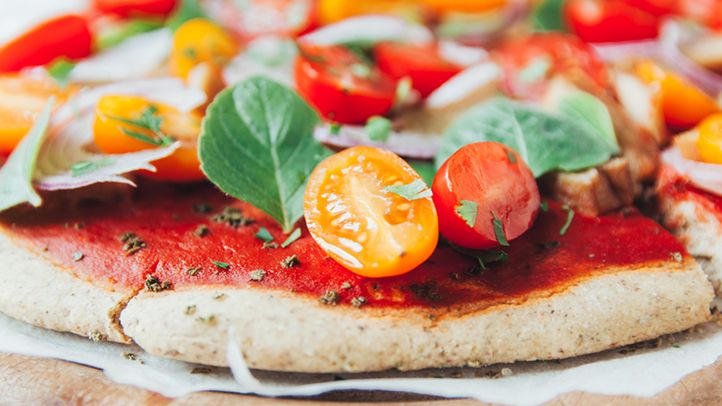1. Eat vegetables on pizza to supplement nutrients
Think of pizza as a scrumptious way to get a lot of veggies into one pan. Add as many vegetables as possible. They’re rich in vitamins and minerals, plus fiber to boot! Kimberlain said.
Not sure which vegetables go well together on a pie? Try Kimberlains’ favorite combination: For a traditional red sauce pizza, I like to add all the veggies, tomatoes, peppers, onions, mushrooms, artichokes, olives, basil. “I love the combination of all of them,” she said. This way, you will get a meal full of nutrients your body needs to grow.
According to Harvard Health Publishing and the USDA, mushrooms are a great way to get vitamin B3 (niacin). One cup of raw, sliced brown mushrooms provides 3 milligrams (mg), which is 21% of your daily value (DV), the Mayo Clinic notes. And this multitasking vitamin helps keep your digestive system, skin, and nervous system healthy.
Meanwhile, bell peppers give you vitamin C, as the USDA notes you get 142 mg per 100 g of peppers, which is more than 150% of the DV.
So when in doubt, add more veggies for a vitamin-packed cake.
RELATED: Which foods have a lot of vitamin C?
2. Choose a thin-crust pizza to cut calories
Whether you order in or make your own pizza, choose thin crust when possible. Why? Lemond says the thin crust means you can eat more vegetables before you’re full.
By going the thin crust route, the main focus of your meal is on the vegetables, not the bread. Why it matters: Eating a more plant-based diet is an all-around healthy way to eat.
For example, one study foundthat people who eat a predominantly plant-based diet, focusing on vegetables, nuts, whole grains, fruits and legumes, have lower mortality rates from heart attacks, strokes and related diseases other cardiovascular effects were lower than in people who ate more foods of animal origin.
The thin crust also has other benefits. Choose a thin crust instead of a thick crust or even a stuffed crust to help reduce total calories and sodium, says Kimberlain.
According to the USDA, a small slice of thin-crust pizza with cheese has 230 calories and 564 mg of sodium. Meanwhile, a slice of thick-crust pizza with cheese has 312 calories and 687 mg of sodium, according to the USDA.
So, to add more veggies to your pizza and reduce calories and sodium, thin crust is your best bet.
3. Pay attention to the type of cheese you choose to limit saturated fat
Most pizza lovers will tell you that cheese is essential to a good pie. However, it’s important to be smart about the type of cheese you add.
Cheese will provide protein and calcium; Just be mindful of how much you add, says Kimberlain, as it also has saturated fat. Choose 2% mozzarella cheese or part-skim ricotta cheese.
Here’s the nutritional information for cheeses that tend to be lower in fat than plain cheeses:
A portion of skinny Mozzarella cheese
According to the USDA, 1 ounce (oz) contains:
- 72 calories
- Total fat 4.51 g
- 2.87 g saturated fat
- 222 mg calcium, 17% DV
The same serving of whole milk mozzarella cheese contains 85 calories, 6 g total fat, 4 g saturated fat, and 143 mg calcium (11% DV).
Partially skimmed Ricotta cheese
According to the USDA, 1 oz contains:
- 39.1 calories
- Total fat 2.24 g
- 1.4 g saturated fat
- 77.1 mg calcium, about 6% DV
In comparison, 1 oz of whole milk ricotta has about 43 calories, 2 g total fat, 2 g saturated fat, and 58 mg calcium (5% DV).
Like Kimberlain, Lemond is a fan of ricotta on cakes. My current favorite way to make pizza is to place these vegetables on top of a layer of ricotta cheese, then broil or broil on a pizza stone, she explains.
RELATED: 5 cheeses you can eat on the keto diet and 5 cheeses you can’t
4. Eat whole-wheat hulls for added nutrition or vegetarian hulls for fewer carbs
Whether you’re making pizza at home or ordering in, it’s important to think about not just thin crust or thick crust but also the type of dough. If you can make your crust with whole grains, this will give you a fiber boost, says Kimberlain.
Consider this slice-by-slice comparison. According to the USDA, a whole-wheat thin-crust pizza with cheese has more than 3 g of fiber. Meanwhile, a regular small thin-crust pizza with cheese has less than 1 g of fiber, according to the USDA. That’s nearly 11% of your DV for fiber in whole wheat versus about 3% for regular crusts. While you still need to pay attention to total serving sizes, starting with a healthier crust can make a difference, she adds.
Vegetarian peels are also a solid choice. “I love alternative pizza crusts on the market or those that can be made yourself, like cauliflower, broccoli and beets, as ways to complement your pizza dinner,” says Kimberlain. Eaten in addition to traditional pie crust to help increase vegetable intake. . That means, for example, you can have a traditional pie crust as well as a vegetarian pie crust to mix things up.
You will also get fiber from the vegetable peel and it is also low in carbs. According to the USDA, frozen cauliflower skins have about 3 g of carbohydrates per slice, and just under 1 g of fiber.
According to the USDA, you’ll also get other nutrients from the cauliflower skins, such as 9 g of protein (thanks in part to the eggs and cheese also included in the recipe).
5. Choose Lean Proteins Like Chicken Instead of High-Sodium, High-Fat Pepperoni
Thanks to cheese, your pizza will already contain protein, but many pizza lovers also add another source of protein, so be mindful of what you put on your pie.
Avoid fatty meats. Go vegetarian or stick to leaner meats like chicken breast, seafood or lean meats, says Lemond.
Kimberlain adds, Current recommendations are to limit intake of processed meats like bacon, sausage and pepperoni, which are not only high in sodium but also high in saturated fat. The AHA recommends minimizing processed red meats such as bacon, hot dogs and sausages.
According to the USDA, a large slice of thin-crust pizza with added vegetables has 5.5 g of saturated fat and 704 g of sodium, while a large slice of thin-crust pizza with added meat has more than 8 g of saturated fat and 874 g. saturated fat. mg sodium, according to USDA.
RELATED: 6 ways carnivores can add more plants to their plates
6. Drizzle with red sauce containing many essential nutrients
Red sauce makes pizza taste delicious, and it also provides many important nutrients. Traditional red sauce will provide vitamins A and C along with the antioxidant lycopene, says Kimberlain. For example, one cup of tomato-based sauce gives you more than 7 mg of vitamin C, which is about 7.8% of your DV, as well as 21 micrograms of RAE vitamin A, for about 2% of your DV, according to the USDA. Meanwhile, vitamin A is important for everything from vision to keeping your immune system working at its best, according to the Mayo Clinic.
Furthermore, lycopene is an antioxidant that gives red fruits and vegetables their color, and it has even been linked to a reduced incidence of certain cancers, as well as a reduced risk of stroke. stroke, according to Harvard Health Publishing.
Kimberlain says red sauce is a better choice than richer sauces like white pizza. The Cleveland Clinic adds that you should also avoid barbecue sauce because it’s high in sugar and sodium.
If you’re not a fan of red sauce, there are other options. You can use pesto made with heart-healthy nuts and oils, says Kimberlain. According to the Mayo Clinic, pesto is made with pine nuts (though you can also substitute almonds or walnuts), and these nuts can do everything from helping lower LDL (bad) cholesterol to improving cholesterol. Improve the health of the lining of your arteries. Pesto is also made with olive oil, which according to the AHA, may reduce the risk of heart disease. Pesto brings out basil and nutty flavors. Just watch how much you’re using, says Kimberlain.
7. Pair your cake with a nutritious side dish to complete your meal
Pizza night isn’t just about the pie, it’s also about what you pair with your slices. Kimberlain says side dishes can play an important role in creating an overall balanced meal.
Try the vegetarian appetizer. “I like to munch on pre-cut vegetables before eating pizza, so celery, cucumbers and carrots combine with a yogurt-based dipping sauce,” says Kimberlain.
Then, when it’s dinner time, she suggests enjoying two slices of thin-crust pizza with a side salad. Kimberlain said vegetables help provide fiber, which plays a role in helping you feel fuller.
For example, 1 cup of raw kale provides 1 g of fiber, according to the USDA. Sprinkle a few other veggies on top (like sliced carrots and cucumbers), then drizzle with a dressing made from lemon juice, olive oil and a pinch of salt, and you’ve got a satisfying, fiber-filled meal. satisfied.
RELATED: 14 healthy lettuces ranked from best to worst
8.Eat slowly to savor your food and enjoy the company
Yes, you’ll want to consider what’s on your plate on pizza night but also think about how quickly you eat. Really enjoy the taste of the dish. Instead of devouring your food in just a few minutes, Kimberlain suggests, slow down and enjoy the pizza. This can also help with your portions. If you eat slowly, you’ll notice when you’re full without overeating. Your protein, grains, and veggies are all in the pizza, Lemond adds, so you just need to eat slowly until you’re satisfied.
Also, don’t forget to enjoy the people you’re dining with. Maybe in your house, Friday night is now pizza night, think of all the memories that can and will be created, says Kimberlain. Why might this be important? Research continues to show the health benefits of friendships, social connections and creating family relationships, she explains.
According to Harvard Health Publishing, strong relationships and social bonds can improve health and increase longevity in a win-win situation. Another study suggests that social connections improve the health of people with long-term illnesses.
Sometimes more important than the food, Kimberlain said, is the tradition that is created.
#Tips #Healthier #Pizza
Image Source : www.everydayhealth.com

